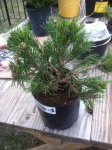DhD47
Mame
Well, I've read al kinds of post from all over and from many from Vance. I'm not sure I got it all correct but I'm going to learn this and with help (thank you Vance and guys) I hope one of these mugos turnes out good. So far I've spent a little time about a month ago cutting back the candles and a few branches.
Now I started to wire the branches and will see what I come up with for style.
Oh yeah, I cleared off the soil from the top to find the base of the trunk and from what I found I like this one.
I know the wire job isn't done and far from a well done job but for my first try ever I think I'm on the right path.
Comments please.

Now I started to wire the branches and will see what I come up with for style.
Oh yeah, I cleared off the soil from the top to find the base of the trunk and from what I found I like this one.
I know the wire job isn't done and far from a well done job but for my first try ever I think I'm on the right path.
Comments please.










